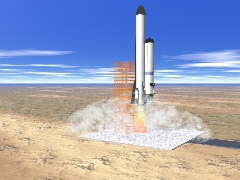
 |
|||||||
|
|
|
|
|
|
|
|
|
|
Sub-Orbital |
Orbital |
LEO Station |
Mission Statement |
Lunar Orbit |
Lunar Surface |
Mars and Beyond |
An infrastructure for reaching low earth orbit is the most important component of any space program. It is also the most expense. The Universal Expeditions Orbital Program consists of developing low cost access for light (5-7 mt, 3 m fairing) and medium (20-25 mt, 4.5 m fairing) capacity launchers--there is no foreseeable economic justification for larger launch vehicles. The goal of these vehicles is to reduce costs to orbit by 50-90%.
If the proposed launch vehicles are not
developed, Universal Expeditions can utilize existing light or medium systems
but a much greater cost.
The light orbital vehicle (LOV) concept is essentially a modified Atlas IIIB. The first stage is powered by an RD-180 kerosene/LOX engine and has enough heat shielding, parachutes and airbags to be recoverable. The upper stage consists of a composite-enhanced Centaur stage with two liquid hydrogen/LOX RL10A-4-2 engines.
For uncrewed cargo missions, the upper stage extends to contain an integrated cargo module with a 7 m long, 3 m diameter payload compartment and a simple manipulator arm. The upper stage/cargo module reenters and lands with parachutes and airbags.
For crewed missions, a 6 mt orbital crew vehicle (OCV) rides atop the upper stage and operates independently on orbit. The OCV is based on the X crew vehicle, but with upgraded internal systems, an OMS engine and 1 ton fuel system. Ideally, a later version of the OCV will incorporate a methane-fueled aerospike propulsion unit that can become the common engine for orbital, lunar and planetary vehicles.
The medium orbital vehicle (MOV) is further off in development. The first stage can consist of a Zenit-derived upgrade of the LOV, or a modification of the proposed Shuttle Liquid Flyback Booster. The upper stage can consist of a upgraded Centaur platform with four engines or upgraded (RL-50?) liquid hydrogen-based engines. The cargo version will accommodate a 13 m long, 4.4 m diameter payload bay, and the crewed version will feature a 20 mt "space bus" capable of carrying a crew of two and up to a dozen passengers.
All pages and images ©1999 - 2005
by Geir Lanesskog, All Right Reserved
Usage Policy
![]()